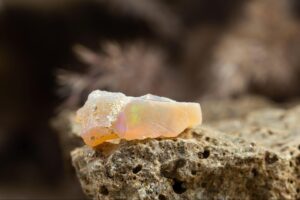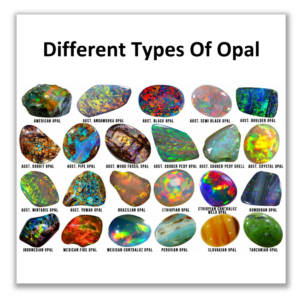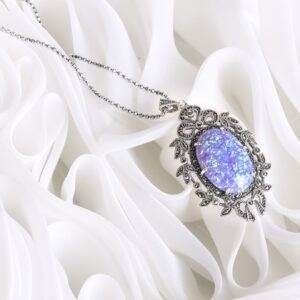Opal is one of the most captivating and unique gemstones in the world. Celebrated for its vibrant play-of-color and mystical beauty, opal has fascinated people for centuries. From ancient mythology to modern gemstone collections, opals are admired for their stunning appearance and symbolic meanings.
In this comprehensive guide, we’ll explore the different types of opals, their physical and metaphysical properties, and essential care tips to keep them shining for years to come.
All About Opal: Types, Properties, and Care Tips

What Is Opal?
Opal is a hydrated form of silica (SiO₂·nH₂O) that forms in cracks and voids within rocks, often sedimentary. Unlike crystalline gems, opal is amorphous, meaning it lacks a specific crystal structure. It contains tiny spheres of silica arranged in a grid-like pattern, which diffract light to produce a spectrum of colors—a phenomenon known as play-of-color.
Types of Opal

1. Precious Opal
- Displays a vibrant play-of-color.
- Includes white, black, fire, and boulder opals.
2. Common Opal (Potch)
- Opaque and lacks play-of-color.
- Found in a variety of colors such as pink, green, and blue.
3. Black Opal
- The rarest and most valuable type.
- Dark body tone enhances the play-of-color.
- Primarily mined in Lightning Ridge, Australia.

4. White or Light Opal
- Pale or white background with rainbow-like flashes.
- Mined in Coober Pedy, Australia.
5. Fire Opal
- Transparent to translucent with warm colors (red, orange, yellow).
- Some have play-of-color; others do not.
- Common in Mexico.
6. Boulder Opal
- Formed within ironstone; retains part of the host rock.
- Known for its brilliant and patterned colors.
7. Ethiopian Opal
- Often hydrophane (absorbs water).
- Can display intense play-of-color.
- Requires special care due to its porosity.
Physical Properties of Opal
- Chemical Formula: SiO₂·nH₂O
- Hardness: 5.5 to 6.5 on the Mohs scale
- Luster: Vitreous to pearly
- Transparency: Transparent to opaque
- Fracture: Conchoidal (shell-like)
- Structure: Amorphous
Due to their relatively low hardness, opals require mindful care to avoid scratches or cracks.
Symbolism and Metaphysical Properties
Opals have been regarded as mystical stones across cultures and eras:
- Creativity and Inspiration: Enhances imagination, intuition, and originality.
- Emotional Healing: Encourages self-expression, confidence, and inner peace.
- Love and Passion: Associated with emotional depth, loyalty, and desire.
- Protection: Believed to shield against negative energy and enhance personal power.Chakra Associations:
- White Opal: Crown chakra (spirituality)
- Fire Opal: Sacral chakra (creativity and sexuality)
- Black Opal: Root chakra (grounding and protection)
- White Opal: Crown chakra (spirituality)
How to Care for Opal
Because opals are relatively soft and contain water, they need gentle handling:
- Avoid Extreme Temperatures: Opals can crack if exposed to rapid changes in temperature.
- Avoid Chemicals: Household cleaners, perfumes, and even prolonged exposure to water (for hydrophane opals) can damage the stone.
- Store Carefully: Keep in a soft pouch or fabric-lined jewelry box away from harder gems.
- Clean Gently: Use a soft cloth with mild, soapy water. Avoid ultrasonic or steam cleaners.
- Moisture Consideration: For hydrophane opals, avoid soaking. For solid opals, occasional storage with a damp cloth can prevent dehydration in dry climates.
Buying Tips for Opals
- Check for Play-of-Color: High-quality opals display a vibrant and multicolored flash from multiple angles.
- Examine Body Tone: Darker body tones typically enhance play-of-color.
- Avoid Cracks and Crazing: Inspect for any visible cracks, as they can worsen over time.
- Ask About Treatments: Some opals are dyed or stabilized—request disclosure and certifications if possible.
Opals are mesmerizing stones that blend natural beauty with spiritual depth. With a wide variety of types and colors, there is an opal for every style and purpose. While they require a little extra care, their dazzling colors and symbolic richness make them a valuable addition to any collection—whether worn as jewelry or cherished for their metaphysical charm.


